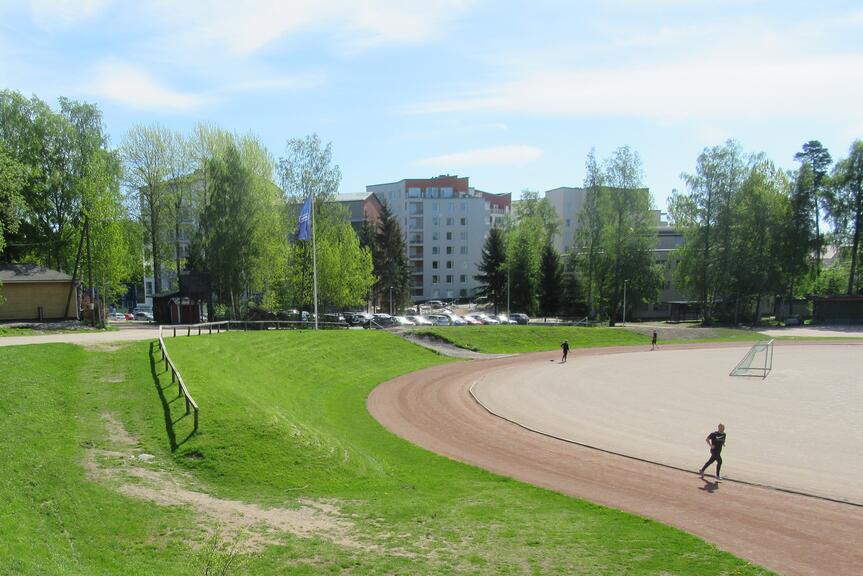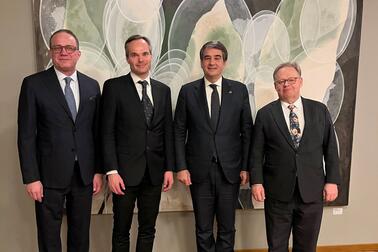
Some of the sports park structures and technology have come to the end of their service life and need to be renewed. The surrounding areas are going to have a lot more residents as the city structure will be densified and altered by urban infill development.
Herttoniemi sports park is currently the only sports service entity in the old Herttoniemi area. There is a demand and need for the sports park renovation, as e.g. local school pupils use the sports park’s fields and exercise facilities in their physical education classes. Football clubs and local residents also actively use the field.
A variety of sports facilities have been planned for the area. The plan is to first build a large sports field and its surroundings. The field will be fenced and upgraded to artificial turf, the stands will be renovated and the grass-covered ramps that also serve as a viewing area will be flared out. A football training ground with artificial turf will later be added to the south-west end of the sports field with a reservation to add a pneumatic structure for winter seasons. The tennis courts, the maintenance building and the maintenance yard will also be renovated.
New sports facilities to be introduced include an outdoor exercise area in the vicinity of the fields as well as a small courts area planned to include a basketball court, mini arena, beach volleyball court and playground. The worn-out tennis courts will also be renovated and replaced by a hockey rink in winter. The large field will serve as a skating rink in winter. More benches and bicycle parking will also be added to the park.
Construction to take place in stages, large sports field to be completed first
Construction is estimated to start towards the end of 2023. Construction will begin with municipal infrastructure, foundation engineering and the large football field, and the first phase of this work is estimated to be completed in 2024–2025. The construction of the entire area should be finalised by 2030.
Plan proposals include planting deciduous and coniferous trees to improve the parks’ comfort and conditions and also separate areas for different sports activities and serve as shelter on windy and sunny days. Natural lawns will be added along the park edges, on the wide lanes in between areas and underneath trees.
The entire park lighting will be renewed and replaced with energy-efficient LED lights as well as modern lighting control. The plans also include adding a transparent net along the edge of the large field to keep any stray balls from getting in the way of other sports park users.
Stormwater management in the area will be enhanced by improving the drainage and levelling of the sports park, among other measures.
Area’s natural and cultural values to be preserved
The planning area has both natural and cultural values. It includes valuable forest, rock and polypore areas as well as reptile and bird areas and plant sites that will remain unchanged. The First World War defence stations located along the edge of the ski jumping hill and in the forest are protected in the detailed plan. The former ski lodge on the western edge of the sports park is also a protected building of cultural-historical value.
The possibility of adding a frisbee golf course in the vicinity of the lodge is currently being examined. The considerable natural values of the area have also been taken into account when planning routes. Planning has been carried out in cooperation with representatives from the Environmental Services and the City Museum, and route locations have been assessed on joint on-site visits. The aim of this route planning has been to find locations that would have as little impact as possible on the local nature, trees and historical sites.
Impact of resident feedback on plans
The interaction with various operators, such as nature organisations, local schools and recreational associations, has been close during the plan preparation process. A residents’ event was held last June, when the draft plan was on display.
The interaction yielded some requests that have been taken into account in the plan by placing the wider tennis backboard further away from residential buildings, adding Finnish baseball lines as well as a high jump and shot-put area in the large field and widening the stand stairs so that they can be used for stair workout. The disc golf course routes were also relocated to areas that are more open.
The final decision on approving the plans will be made by the Urban Environment Committee, which will discuss the plans at its meeting next Tuesday, 31 January. If the plans are approved, construction could begin already this autumn.
